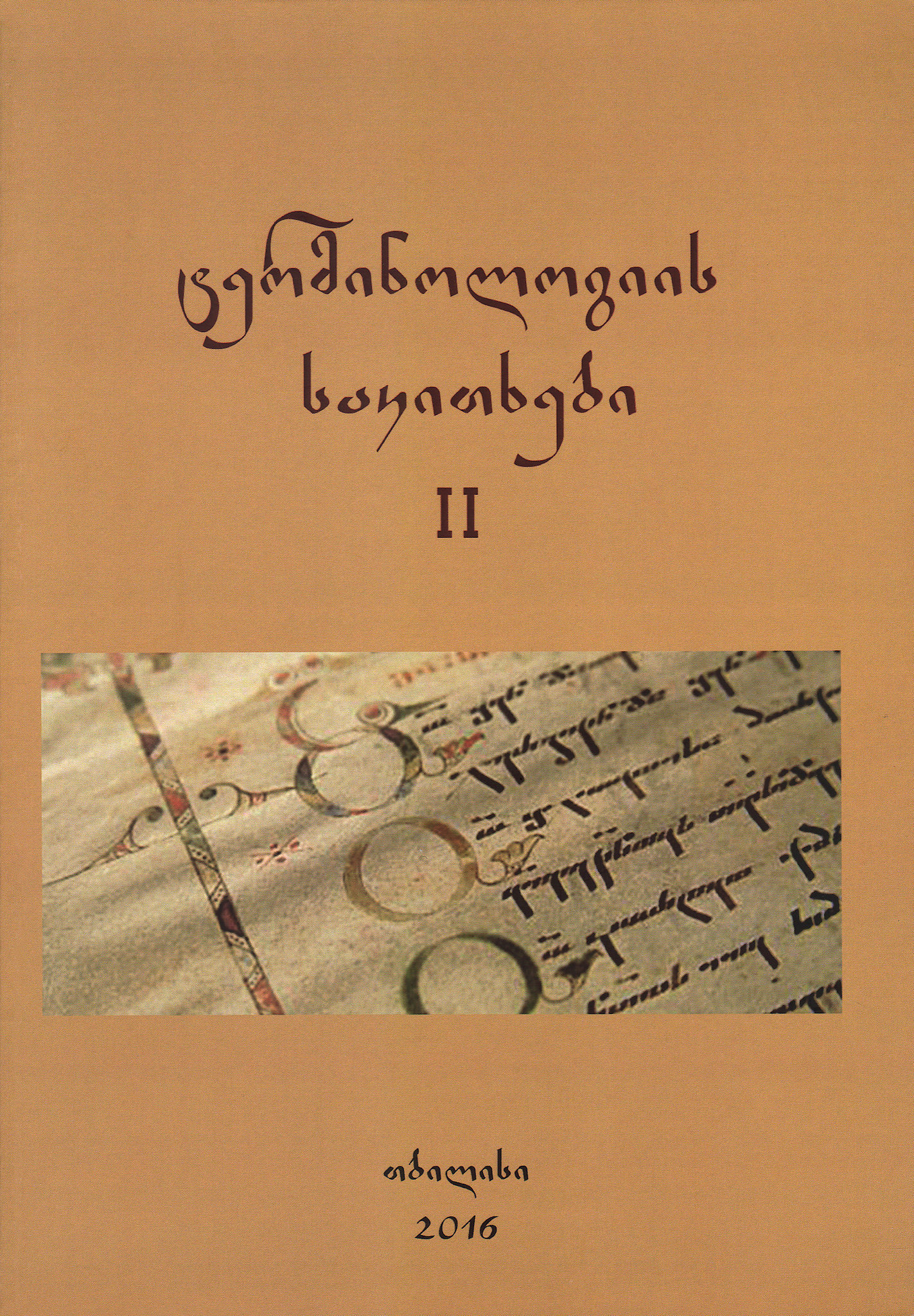მცენარეთა სახელების აგებულებისა და სახელდების შესახებ ქართულ ენაში (რუსულ და გერმანულ ენებთან შეპირისპირებით)
საკვანძო სიტყვები:
მცენარეთა სახელწოდებები, სიტყვაწარმოება, შეპირისპირებითი კვლევაანოტაცია
The names of the plants compose one of the oldest linguistic stratum and it provides very interesting material for contrastive linguistic researches. Nomination of the phytonyms is closely tied to the means of the word derivation and composition. One- or two-component, simple, derivated or compound words are evident among the main derivation models of the phytonyms in Georgian. Derivative suffix -ა (a) prevails: angeloza (angelica), boloka (small cabbage white), kelapṭara (broomrape). It occurs in combination with other suffixes: baKaKura (Saint-Mary-thistle), bolokura (wild radish), santela (cow-wheat); Suffix -a as a connector in the compound words: didgula (bourtree), tetrKvavila (snowdrop), baṭknisKura (catchweed), gveliskovza (swallow-wort). Two-component syntagmas are also frequent in Georgian: datvis kenkra (bear's ear), irmis-rka (crape myrtle, lendia), ʒaγlis-ena (hound's-tongue)... šavi askili (Rosa eglanteria), tetri gogra (white squash), witeli gvirila (pink camomile), samkurnalo salbi (garden sage), evropuli abrešuma (european dodder). As for the phytonyms in Russian here simple-stem nouns and word-compositions are common, and in German we meet abundance of the composites with transparent motivation.
Attitude to the given object or phenomenon is reflected in its nomination which results in creation of the “Linguistic picture of the world”. The means of nomination of the phytonyms in Georgian, Russian and German are similar to other languages, i.e. derivation, composing and semantic shifting.
There are several notable works on the subject of the Georgian phytonyms (B. Jorbenadze, N. Khocholava, M. Ivanishvili, M. Makashvili...) but they do not concern the contrastive analysis of this issue in the unrelated languages.
Observing the phytonyms reveals that in Georgian, Russian and German different means are used to nominate the same phytonyms though the general principles are common. A specific choice depends on the perceptions of the nominator – what resemblance they see with other objects, natural phenomenon or creature. Traditions, beliefs and mythological images also matter.
We distinguish some groups among the means of nomination of the phytonyms:
I. Nomination according to the area of the plants expansion;
II. Nomination according to the physical features of the plants: a) color; b) form (or other features);
III. Nomination according to the resemblance with birds, animals or insects;
IV. Nomination according to the physiological characteristics of the plants: a) taste; b) curative abilities or some impact;
V. Nomination according to the metaphoric resemblance.
Comparing the names of the plants contrastively in Georgian, Russian and German languages shows that there are much more difference than resemblance in the structure and the means of nominations alike.
წყაროები
ბროკჰაუზი, ევფრონი, 2012 – Брокгауз, Евфрон, Энциклопеди-ческий словарь, 2012: http://slovar.cc/enc/brokhauz-efron2/1890653.
ეთნობოტ. 2010 – Этноботаника: растения в языке и культуре (Отв. ред. В.Б.Колосова, А. Б. Ипполитова), СПб.: Изд-во «Наука», 2010. – 386с.
ივანიშვილი, 2014 – მ. ივანიშვილი, მცენარეთა სახელები ქარ-თველურში, თბილისი: გამომც. „ნეკერი“, 2014. – 250.
ირიცპუხოვა, 2013 – ნ. ირიცპუხოვა, მოტივაცია სახელდების პროცესში: გრიგოლ რობაქიძის სახელობის უნივერსიტეტის სტუ-დენტთა საერთაშორისო სამეცნიერო კონფერენცია, თბილისი, 2013.
კუზნეცოვა, 2009 – Кузнецова Е.Л., Отражение лечебных свойств лекарственных растений во внутренной форм к русских диалектных и литературных номинаций: Веснік БДУ, Сер. 4, 2009, No3. 60.
ლელ, 1990 – Лингвистический энциклопедический словарь. – М.: СЭ, 1990. – С. 336 – 337.
ა. მაყაშვილია,1961 – ა. მაყაშვილი, ბოტანიკური ლექსიკონი, მცენარეთა სახელწოდებანი, თბილისი: საბჭოთა საქართველო, 1961. – 260გვ.
ზ. მაყაშვილი, 1996 – ზ. მაყაშვილი, მცენარეთა სახელდება (რედ.: ნ. რატიანი), თბილისი: მეცნიერება, 1996. – 176გვ.
მ. მაყაშვილი, 2011 – მ. მაყაშვილი, მცენარეთა სახელდება ქარ-თულ ენაზე: ჟურნ. „სემიოტიკა“, 2011, №9, გვ. 123-127.
მაჭავარიანი, 2004 – ნ. მაჭავარიანი, მცენარეთა ლექსიკა აფხა-ზურში (სემანტიკურ-სტრუქტურული ანალიზი): სადოქტ. დისერტა-ცია, თბილისი, 2004. – 230გვ.
სერებრენიკოვი... 1977 – Серебренников Б.А., Уфимцева А.А., Серебренников Б.А., Уфимцева А.А., Языковая номинация (виды наименований), – М.: Наука, 1977. – 356 с.
შუმბასოვა, 2011 – Шумбасова С.С., Английские флоронимы: Способы номинации и классификации: Вестник МГГУ им. М.А. Шолохова. Филологические науки, 2011, №3: http://cyberleninka.ru /article/n/angliyskie-floronimy-sposoby-nominatsii-i-klassifikatsii
ხოჭოლავა, 2006 – ნ. ხოჭოლავა, მცენარეთა სახელდება ქარ-თულში: საკანდ. დისერტაცია, თბილისი, 2006. – 189გვ.
ჯორბენაძე, 1990 – ბ. ჯორბენაძე, მცენარეთა სახელდების პრინ-ციპისათვის ქართული ენის დიალექტებში: იკე, XXIX, თბილისი, 1990, გვ.84-93.
ჯორბენაძე, 1997 – ბ. ჯორბენაძე, ენა და კულტურა (რედ.: გი-ორგი გოგოლაშვილი), თბილისი, 1997. – 204გვ.





